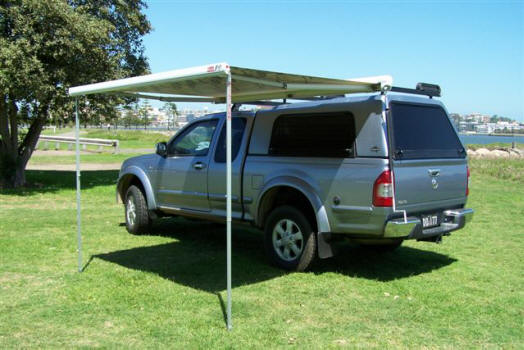|
vehicle awnings
a
selection guide

Vehicle awnings have become very popular over the last few years and
there are plenty on the Australian market to tempt you. They are a
really good addition to your camping setup, are easy to erect and
give you shelter from the sun and rain in the bush. A vehicle awning
is a perfect shelter for a quick lunch stop or for an extended stay.
But, as with most things today, not all awnings are created equal
and the old saying “you get what you pay for” applies here too.
There are two main styles of awning available,
the “cassette” style used mainly on caravans and campervans and the
“bag” style awning found on many 4wheel drives today. The “cassette”
awnings tend to be more expensive and require stronger mounting
points whereas the “bag” awnings are lighter and can be easily
mounted to roof bars and lighter roof racks.
bag awnings
Within the bag awning range there are a number of
options to choose from.
* Basic: side & rear awnings with two
loose poles and guy ropes.
*Mid Spec: side and rear awnings that are
a little more sophisticated with side bracing poles to tension the
canvas and vertical telescoping poles fixed to an integrated end
tube. These are largely self contained and all the bits fit inside
the awning bag.
*Deluxe: models with sophisticated
aluminium profiles that add to the strength and allow for sturdy
enclosure options. Some even have custom fittings that negate the
need for guy ropes.
wing awnings
Wing awnings: these awnings give you the best of
both worlds, side and rear cover all in one. These “wing” style
awnings are very versatile but take a little longer to set up and
pull down.
main components
There are four main components to these
awnings – the canvas, the pole system, the mounting system and the
bag.
canvas
In my opinion, the canvas is the most important part of an awning as
it provides the shade from the sun and shelter from the rain. The
lower cost awnings tend to use thinner, rip-stop style canvas that
offer inadequate shading and insulation from the sun on a hot day
(particularly in our northern climate). Do the test, look up from
underneath the awning at the sun – if you can see through it the
shade and durability factor is likely to be less than satisfactory.
Compare it to another model using higher grade canvas – you will see
the difference. Look for at least 11oz, Australian-made, Dyna-proofed
canvas that is both rot and mildew resistant.
poles
Check how good the telescoping poles are -
tighten up the twist lock mechanism and then put some weight on them
(hang off them unless you weigh more than 90 kg’s). If they compress
under your weight, they probably require constant adjustment in
windy conditions – this can become tiresome and annoying after a
while.
Check if the inner pole glides smoothly and
noiselessly inside the outer - undo the lock and slide the inside
pole up and down a few times and if it’s noisy or rough chances are
the mechanism is of poor quality and may disappoint in the field.
Make sure the aluminium poles are anodised. Raw aluminium discolours
with oxidisation, leaves black marks on your canvas and hands and
becomes unsightly over time.
mounting system
Examine the plastic fittings on the end of the
poles – it’s harder to judge the quality of these but give them a
good flexing to see if they are flexible or brittle. If you are
afraid of breaking something, ask the salesman to do the flex test.
If they have some give in them, it’s likely that good quality
plastics have been used on the awning.
Make sure all metal fittings are stainless steel
and included in the package and purchase price – are the mounting
brackets included? Zinc plated fittings will corrode long before
stainless steel which is why the marine sector will only use
stainless fittings.
Ask if there are spare parts available in the
event of something breaking – if not, you may have to throw that
broken awning away because there are no parts available for repair.
Ask for a price and availability on a replacement pole – if you
can’t get it straight away at a reasonable price look at other
options.
awning bag
The awning bag is what protects your investment from external damage
when not in use – look for a good, strong vinyl bag with an enclosed
zip to minimise water ingress.
conclusion
Is it Australian made? Locally made products tend
to cost more but chances are the overall quality will be better than
on an imported awning and you will be doing your bit to keep
manufacturing alive in Australia. Local manufacturers also offer a
greater range and will often make the awning to your specifications
- with imports, you get what is on offer and customisation is
generally not an option. After sales support and parts availability
is generally also better with locally manufactured awnings
We are all constrained by budget to some degree
but in my experience the better quality products tend to last a long
time if maintained properly and paying a bit more up front gives you
more comfort that the product will perform in our harsh environment.
I remember a few times where my time in the bush was cut short by
equipment failure caused by inferior products.
thanks to Franz G. Haidinger
april 2013
|